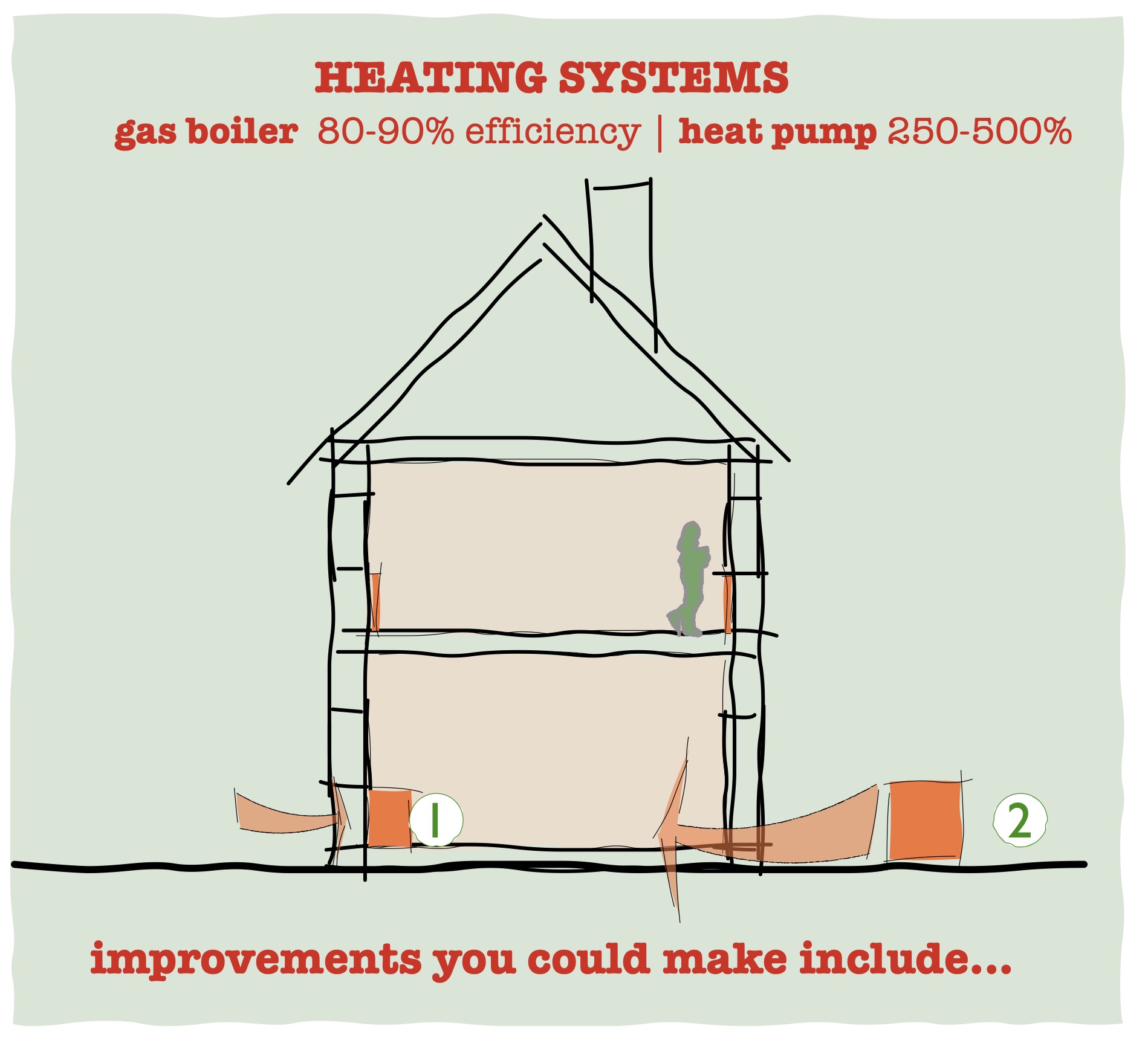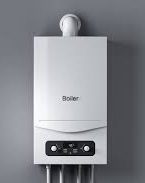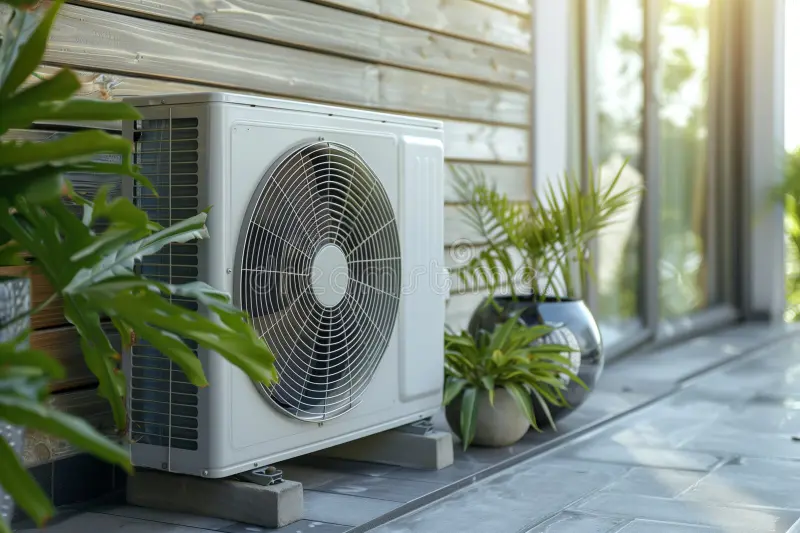
Existing Systems
Gas boilers and Radiators
In this era, central heating systems became the norm. Gas boilers form the vast majority of local heating systems, and represent perhaps the biggest challenge to reducing CO2 emissions in homes.
Oil boilers and Radiators
Although far fewer in number, oil boilers in general need to be replaced with lower emitters of CO2.
Retrofit Opportunities: Both oil and gas boilers are ideally replaced at the end of their lives – typically 10-20 years – e.g. with Air Source Heat Pumps.
Electric Heating
Some homes will still have storage heaters – considered inflexible and cumbersome nowadays – or other forms of electric heating. Most of these are far less efficient than Air Source Heat Pumps, and may be suitable for replacement.
Open fires
Very few houses from this era will have open fires, as coal-fired heating became less-and-less favoured.
Wood-burners
There has been a more recent resurgence in the use of wood-burning stoves. These are controversial, particularly in urban areas – potentially adding significantly to air pollution through the emission of particulates. They can only be classed as using renewable energy if the wood burned is replanted to sequester the CO2 released through burning.
Air-Source Heat Pumps [ASHPs] – WHY ?
There is a broad campaign – backed by governments and climate groups alike – to equip the housing stock with ASHPs, for two main reasons:
- If installed properly, they are 3-5 times more efficient than, for example oil and gas boilers, and therefore use much less energy.
- They run on electricity, which is increasingly becoming ‘greener’ as the national grid uses more and more renewable energy.
Air-Source Heat Pumps [ASHPs] – HOW ?
Designing and installing a heat-pump system requires specialist knowledge, to…
- Measure and calculate the heat-loss of the building – measuring the heat loss of all building elements – eg roofs, walls, openings, floors…
- Assess the existing heat distribution – normally radiators – and hot water system
- Calculate the size of the required heat pump
- Design the system, including upgrading radiators and/or pipe-work where necessary
- Installing, optimising, and guaranteeing the performance of the new system
Thus, a specialist contractor is required. However, there is a very accessible local service available to provide an assessment of your needs, and to assist you on your path to lower emissions – details here.
Air-Source Heat Pumps [ASHPs] – HOW MUCH ?
Each ASHP installation is unique, and therefore impossible to cost accurately without the above package of assessment and design.
As of summer 2025, a government ‘Boiler Upgrade Scheme’ grant of £7,500 is available. Please check the current position here. The grant might pay for half or more of the overall cost, so is well worth investigating.
Running costs depend on:
- The efficiency of the system – measured as its SCOP [Seasonal Co-efficient Of Performance], and
- Energy tariffs – these change frequently, but can be checked easily on-line through your energy supplier.
- Many predict that, as the national grid becomes more and more ‘de-carbonised’ [ie uses more renewables, less fossil fuels], prices will drop. This remains to be seen.
Renewable Energy Suppliers
With the increasing conversion of the national grid to renewable energy generation, perhaps the best strategy to reduce carbon emissions [after converting heating to an electrical source], is to switch to a 100% renewable supplier. See online comparison sites – e.g which?.
However, some home owners are keen to generate their own renewable power, via Solar PV, wind or even water power.
Solar PV
Solar Installation costs are reducing year by year, and therefore becoming more attractive to home-owners. A small array of panels – up to around 3.5kWp [the measure of peak output on a sunny day] will normally be possible without prior approval by the power supplier.
This may comprise some 10 or so panels, approx 1.7m [5’6″] x 1m[3’3″]. Fitting these onto existing roofs, preferably on a south-facing slope, may be challenging. Any reputable local supplier [registered with MCS] can advise on this, and there are many on-line tools which may help. MCS-certified installers can be found here.
Listed Building Status will likely limit the options for Solar PV. Ensure you check with B&NES conservation dept, or get advice via the links below.
Wind power
This is a far less likely source of generation in most urban locations, and needs specialist advice -e.g Retrofit West and BWCE – see Home Assessments drop-down below.
Water power
Unless your property is next to a water-course, this is unlikely to be an option, and even if it is, would be a very challenging process !
Heat Pumps
Air Source Heat Pumps [and ground-source and water-source] extract the heat in the surrounding environment, by means of electric-powered heat pumps . Their efficiency, measured as the SCOP – Seasonally adjusted Co-efficient Of Performance – determines how much of this heat energy they extract.
Heat Pumps, can be powered from solely or mainly renewables, via a renewable tariff [see above]. We have more information on heat pumps here and here
A common myth is that heat pumps only work with smaller or better insulated buildings. Whilst true that they work better in that situation, virtually no buildings cannot be heated by heat pumps. Click the following link for a fairly extreme domestic example, though be aware this is effectively an advertisement, and cannot therefore be endorsed by GGW… YouTube link
Widcombe contains many Listed Buildings, which present special challenges to retrofitting, as any improvements that are judged by the Local Planning Authority [LPA] to affect the character of the building will need Listed Building Consent [LBC].
Historically, this has led to clashes between the aims of energy conservation and heritage conservation. However, recent changes in policy resulting from the climate crisis are placing greater emphasis on energy efficiency to reduce carbon emissions.
B&NES Advice
Every Listed Building presents a unique set of circumstances, and requires assessment by the LPA’s [B&NES] conservation team.
In response to the Climate Emergency, B&NES Council has developed a new level of pre-application advice, unique in the UK, to help owners of Listed Buildings to make them more energy efficient.
This ‘Service Level Zero’, unlike a standard pre-application, does not require a proposal and is aimed at homeowners who are interested in improving the energy of their listed building but don’t know where to start.
This service is for owners and occupiers of Listed Buildings within Bath and North East Somerset who are looking at ways to improve the energy efficiency of their building. The Conservation Officer will visit the site and provide tailored technical and conservation advice based on your property and the suitability of measures discussed, as well as any other factors such as budget. This service is suitable for the following:
- Solar panels.
- Energy saving ‘quick wins’ to save energy and water which may not require Listed Building Consent
- Draughtproofing
- Secondary glazing and/or slim-profile double glazing
- Internal wall, loft, and/or floor insulation
- External wall insulation
- Upgrading of existing heating and hot water systems
- Heat pumps
BWCE Guidance
Bath And West Community Energy, a not-for-profit partner of GGW, work closely with B&NES in this field:
Widcombe lies within the Bath Conservation Area – see below.
This applies another set of planning rules, whether your building is listed or not.
Whilst generally less restrictive than Listed Building status, external changes to a property may well be constrained if they are seen as affecting the character of the area, distinct from the character of the building itself.
In Bath, we also have our World Heritage Area and Cotswolds AONB status, although these are less likely to affect the acceptability of retrofit projects.
To check the Bath Conservation Area and other planning area boundaries, click this link:.
Whilst a few retrofit measures such as draught proofing and loft insulation are suitable for residents to undertake by themselves, or with the help of local tradespeople, in some cases without needing consent, the majority of measures, particularly to older buildings, need professional advice and guidance.
This is necessary to avoid creating new problems, such as reducing uncontrolled ventilation [ie. draughts !] and increasing moisture within the building – potentially very damaging.
Several local Not-for-Profit agencies offer low-cost Home Energy Surveys. These include two of our key partners – RETROFIT WEST and BWCE – see links below for their current offers. GGW strongly advocates such surveys, as a way of providing expert advice and assistance on your ‘retrofit path’…

